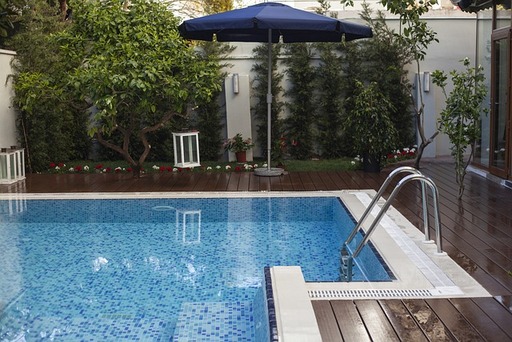
Owning an outdoor swimming pool is a gateway to relaxation and enjoyment, providing a refreshing escape right in the comfort of your backyard. However, maintaining that crystal-clear water, inviting for a perfect dip, requires a bit of effort and know-how. In this guide, we delve into the essential aspects of cleaning and maintaining your outdoor swimming pool, ensuring it remains a sparkling oasis that beckons you for a swim. Let’s explore the straightforward yet detailed steps needed to achieve and sustain that coveted crystal-clear brilliance, making your pool not just a centerpiece of recreation but a testament to meticulous care and attention.
A crystal-clear pool isn’t just about aesthetics; it’s about creating a safe and inviting environment for you and your loved ones. From skimming away debris to understanding the nuances of water chemistry, each step contributes to the overall health and clarity of your pool. In this journey of pool maintenance, we’ll unravel the simplicity behind each task, making it accessible to every pool owner. So, whether you’re a seasoned pool enthusiast or diving into pool ownership for the first time, let’s embark together on a guide that ensures your outdoor swimming pool remains not only a source of joy but a glistening haven for relaxation.
See also our post on Green Cleaning for Outdoor Cushions: Comfortable and Earth-Friendly
Skimming and Surface Cleaning
Regular Skimming
Skim the pool’s surface daily to remove leaves, debris, and insects. A simple skimmer net is your best friend in keeping the water clear of unwanted visitors.
Invest in a Pool Cover
Use a pool cover when the pool is not in use. This prevents leaves and other debris from falling into the water, reducing the workload for regular skimming.
Address Wind Patterns
Be aware of prevailing wind patterns around your pool. Positioning plants or barriers strategically can minimize the amount of debris blown into the pool.
Trim Overhanging Trees
Trim branches and foliage of trees near the pool regularly. This minimizes the number of leaves falling into the water and reduces the need for constant skimming.
Clean Out Skimmer Baskets
Empty skimmer baskets frequently. This ensures they don’t become clogged, allowing the skimmer to efficiently catch debris from the pool’s surface.
Tips for Vacuuming and Cleaning the Pool Bottom
Use a Pool Vacuum
Invest in a pool vacuum to clean the pool bottom. Regular vacuuming removes dirt, algae, and other particles, preventing them from settling and clouding the water.
Brush Pool Walls and Floor
Brush the pool walls and floor weekly to dislodge any algae or dirt. This not only maintains a clean appearance but also prevents the growth of slippery or unsightly substances.
Focus on Nooks and Corners
Pay special attention to nooks, corners, and areas with poor water circulation. These spots can accumulate debris and algae, affecting the overall clarity of the pool.
Choose the Right Brush
Select a brush suitable for your pool’s surface – whether it’s plaster, vinyl, or fiberglass. Using the correct brush prevents damage and ensures effective cleaning.
Vacuum in Different Directions
When vacuuming, vary your directions to cover the entire pool bottom systematically. This ensures no area is left untouched and maintains consistent water clarity.
Pool Filtration System Maintenance
Check and Clean Filters
Regularly inspect and clean pool filters. Dirty filters hinder water flow and reduce their efficiency in trapping debris, affecting the pool’s overall cleanliness.
Backwash Sand Filters
For pools with sand filters, backwash the system as recommended by the manufacturer. This process cleans and refreshes the filter medium, promoting optimal filtration.
Monitor Pressure Gauges
Keep an eye on pressure gauges on the pool’s filtration system. A sudden increase in pressure indicates a clogged filter that needs immediate attention.
Schedule Professional Filter Cleaning
Consider scheduling professional filter cleaning periodically. This ensures a thorough inspection and maintenance, extending the lifespan of your pool’s filtration system.
Upgrade to High-Efficiency Filters
Explore high-efficiency filters for your pool. Although initially more expensive, they offer superior filtration, reducing the need for frequent cleaning and enhancing water clarity.
See also our post on Green Cleaning for Outdoor Windows: Crystal Clear and Eco-Friendly
How to Balance Pool Chemicals
Regular Water Testing
Conduct regular water testing to check pH levels, chlorine, and alkalinity. Maintaining proper chemical balance is crucial for preventing algae growth and maintaining clear water.
Adjust pH Levels
Keep pH levels within the recommended range (usually 7.4 to 7.6). This ensures that chlorine remains effective in killing bacteria and algae, promoting clear water.
Shock Treatment
Perform shock treatments when needed, especially after heavy pool usage or extreme weather conditions. This helps eliminate contaminants and restores water clarity.
Use Algaecides Preventatively
Consider using algaecides as a preventive measure. These chemicals inhibit algae growth, preventing green or cloudy water and reducing the need for extensive cleaning.
Consider Salt Chlorination
Explore salt chlorination systems as an alternative to traditional chlorine. These systems provide a consistent release of chlorine, resulting in clearer water and softer pool experiences.
Regular Water Circulation
Optimize Pump Operation
Ensure your pool pump operates optimally. Regularly check for any signs of malfunction and repair or replace components as needed.
Run the Pump Adequately
Run the pool pump for an adequate amount of time each day. This ensures proper water circulation, preventing stagnation, and promoting even distribution of pool chemicals.
Use Pool Jets Strategically
Direct pool jets strategically to promote water movement. This prevents debris from settling and encourages uniform distribution of chemicals for effective water treatment.
Consider Variable Speed Pumps
Invest in variable-speed pumps for energy efficiency. These pumps allow you to adjust the speed based on your pool’s needs, promoting optimal water circulation.
Invest in a Robotic Pool Cleaner
Consider using a robotic pool cleaner to supplement pump and filter efforts. These devices efficiently clean the pool bottom and walls, reducing the workload on the filtration system.
Pool Deck and Surrounding Area Maintenance
Regular Deck Sweeping
Sweep the pool deck regularly to prevent dirt and debris from entering the pool. This simple step contributes significantly to maintaining water clarity.
Trim Landscaping Plants
Trim plants and shrubs near the pool area to minimize the number of leaves and flowers falling into the water. This reduces the risk of contaminants.
Manage Runoff
Ensure proper drainage around the pool area to prevent rainwater or runoff from carrying debris into the pool. Proper runoff management supports pool water cleanliness.
Clean Surrounding Surfaces
Regularly clean surfaces surrounding the pool, including furniture, umbrellas, and toys. This prevents these items from introducing dirt or contaminants into the water.
Address Sunscreen Residue
If sunscreen residue is a concern, encourage pool users to shower before swimming. This helps remove oils and lotions, preventing them from clouding the pool water.
Seasonal and Periodic Pool Maintenance
Winterization
If you live in a region with cold winters, consider winterizing your pool. This involves draining water to below the skimmer and using a winter cover to protect the pool from debris and freezing.
Professional Pool Inspections
Schedule professional pool inspections annually. A trained technician can identify potential issues before they become major problems, ensuring your pool stays crystal clear.
Tile and Grout Cleaning
Periodically clean pool tiles and grout to remove any built-up grime or algae. This contributes to the overall aesthetics of the pool and prevents waterline stains.
Address Cracks and Leaks
Promptly address any cracks or leaks in the pool structure. Water loss can affect chemical balance and filtration efficiency, impacting the clarity of the pool water.
Reevaluate Pool Design
If persistent issues arise, consider reevaluating your pool’s design. Changes in landscaping, drainage, or filtration systems may be necessary for long-term water clarity.
See also our post on How to Clean and Maintain Your Outdoor Fire Pit: Cozy Evenings
Conclusion
As we come to the end of our discussion about cleaning and maintaining your outdoor swimming pool, keep in mind that a crystal-clear pool is not only a visual treat but also an indication of a well-kept aquatic sanctuary. By adding these easy-to-follow yet meticulous steps to your routine, you are guaranteeing a spotless and welcoming swimming area. From skimming leaves to balancing chemicals and utilizing modern pool technology, every element contributes to the clarity and health of your pool water. So, as you begin this journey of pool care, picture the delight of jumping into water that is so clear it glistens – a genuine testament to your dedication to a beautiful and refreshing outdoor swimming experience.







